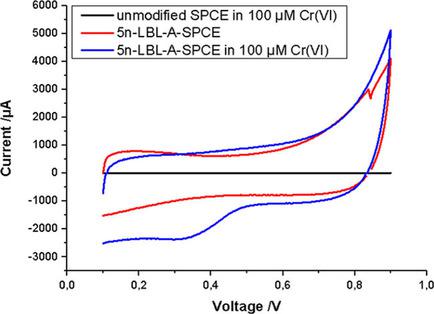当前位置:
X-MOL 学术
›
Electroanalysis
›
论文详情
Our official English website, www.x-mol.net, welcomes your feedback! (Note: you will need to create a separate account there.)
Natural Melanin Nanoparticle‐decorated Screen‐printed Carbon Electrode: Performance Test for Amperometric Determination of Hexavalent Chromium as Model Trace
Electroanalysis ( IF 3 ) Pub Date : 2020-03-30 , DOI: 10.1002/elan.202000038 Gizem Kaleli‐Can 1 , Busra Ozlu 2 , Hatice Ferda Özgüzar 3 , Baran Onal‐Ulusoy 4 , Gözde Kabay 3 , Taesik Eom 2 , Bong Sup Shim 2 , Mehmet Mutlu 5
Electroanalysis ( IF 3 ) Pub Date : 2020-03-30 , DOI: 10.1002/elan.202000038 Gizem Kaleli‐Can 1 , Busra Ozlu 2 , Hatice Ferda Özgüzar 3 , Baran Onal‐Ulusoy 4 , Gözde Kabay 3 , Taesik Eom 2 , Bong Sup Shim 2 , Mehmet Mutlu 5
Affiliation

|
A biosensor was prepared with natural melanin nanoparticles (MNP) decorated on a screen‐printed carbon electrode (SPCE). Hexavalent chromium was selected as a well‐known heavy metal ion to be detected for testing the performance of novel biosensor. Natural MNP was extracted from cuttlefish (Sepia officinalis ) ink. Surface decoration of SPCEs with MNP was performed by two different methods. The first one was layer‐by‐layer assembly (LBL‐A) for different cycle times(n). In the second one, plasma treatment of SPCE incorporated with evaporation‐induced self‐assembly (EI‐SA) techniques including different incubation times in MNP solutions. The performance of both modified SPCEs were tested for amperometric detection of Cr(VI) in various water samples, and peak reduction of Cr(VI) was determined at 0.33 V. Amperometric results showed wide linear ranges of 0.1–2 μM and 0.1–5 μM of Cr(VI) for SPCEs modified with 14n‐LBL‐A and 12h‐EI‐SA, respectively. The sensitivities of SPCEs modified with 14n‐LBL‐A and 12h‐EI‐SA techniques were 0.27 μA μM−1 and 0.52 μA μM−1, respectively. In addition, both modified SPCEs selectively detected Cr(VI) in a model aqueous system composed of certain other heavy metals and minerals, and tap and lake water samples. The LOD and LOQ values for 12h‐EI‐SA were 0.03 μM and 0.1 μM, respectively. This showed that MNP‐modified‐SPCEs generated via EI‐SA techniques have the potential to be an alternative to conventional detection methods such as ICP‐MS.
中文翻译:

天然黑色素纳米粒子修饰的丝网印刷碳电极:电流法测定六价铬作为模型痕量的性能测试
制备了一种生物传感器,其天然黑色素纳米颗粒(MNP)装饰在丝网印刷的碳电极(SPCE)上。六价铬被选为众所周知的重金属离子,可用于测试新型生物传感器的性能。天然MNP提取自墨鱼(Sepia officinalis)墨水。通过两种不同的方法对带有MNP的SPCE进行表面装饰。第一个是在不同的循环时间(n)下进行的逐层组装(LBL-A)。在第二篇文章中,SPCE的等离子体处理结合了蒸发诱导自组装(EI-SA)技术,包括在MNP溶液中的不同孵育时间。测试了两种修饰的SPCE的性能,以用于安培检测各种水样中的Cr(VI),并确定了Cr(VI)的峰值还原为0.33V。安培结果显示0.1–2μM和0.1–5的宽线性范围分别用14n-LBL-A和12h-EI-SA改性的SPCE的Cr(VI)的μM。SPCEs的灵敏度改性14N-LBL-A和12h-EI-SA技术是0.27μAμM -1和0.52μAμM -1, 分别。此外,两种改性的SPCE在由某些其他重金属和矿物质以及自来水和湖水样品组成的模型水系统中选择性地检测了Cr(VI)。12h-EI-SA的LOD和LOQ值分别为0.03μM和0.1μM。这表明通过EI-SA技术生成的MNP修饰的SPCE有可能替代ICP-MS等常规检测方法。
更新日期:2020-03-30
中文翻译:

天然黑色素纳米粒子修饰的丝网印刷碳电极:电流法测定六价铬作为模型痕量的性能测试
制备了一种生物传感器,其天然黑色素纳米颗粒(MNP)装饰在丝网印刷的碳电极(SPCE)上。六价铬被选为众所周知的重金属离子,可用于测试新型生物传感器的性能。天然MNP提取自墨鱼(Sepia officinalis)墨水。通过两种不同的方法对带有MNP的SPCE进行表面装饰。第一个是在不同的循环时间(n)下进行的逐层组装(LBL-A)。在第二篇文章中,SPCE的等离子体处理结合了蒸发诱导自组装(EI-SA)技术,包括在MNP溶液中的不同孵育时间。测试了两种修饰的SPCE的性能,以用于安培检测各种水样中的Cr(VI),并确定了Cr(VI)的峰值还原为0.33V。安培结果显示0.1–2μM和0.1–5的宽线性范围分别用14n-LBL-A和12h-EI-SA改性的SPCE的Cr(VI)的μM。SPCEs的灵敏度改性14N-LBL-A和12h-EI-SA技术是0.27μAμM -1和0.52μAμM -1, 分别。此外,两种改性的SPCE在由某些其他重金属和矿物质以及自来水和湖水样品组成的模型水系统中选择性地检测了Cr(VI)。12h-EI-SA的LOD和LOQ值分别为0.03μM和0.1μM。这表明通过EI-SA技术生成的MNP修饰的SPCE有可能替代ICP-MS等常规检测方法。



























 京公网安备 11010802027423号
京公网安备 11010802027423号